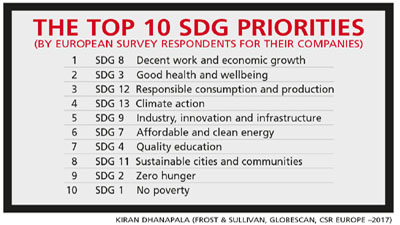SUSTAINABILITY AGENDA
CHANGE OR TRANSFORMATION?
Creating a more sustainable world – by Kiran Dhanapala
Moving towards creating a more sustainable world has been a goal shared by many for some time. But is it change or transformation that will get us there? Change often implies superficial modifications that if halted will take us back to where we began. Therefore, it entails a high risk of reverting to the status quo.
Alternatively, transformation is deeper and involves more systemic shifts that move us to a new paradigm entirely. True sustainability is transformative regardless of whether it’s at the organisational or country level.
Yet, ‘how’ is the critical question.
Given that sustainable development as encapsulated in the Sustainable Development Goals (SDGs) and sustainability are multifaceted, it will naturally require initiatives on multiple fronts and at several levels. This ambitious goal cannot be achieved alone. It will involve complex partnerships and collaborations, and a layering of initiatives over time.
At the country level, sustainability is best captured in a nation’s prioritisation of SDGs. And prioritisation often leads to a road map, which is coordinated and reported on transparently.
For some countries, this means moving towards a 100 percent renewable energy goal and clean practices. When President Donald Trump served notice that the US was pulling out of the Paris Agreement, Presidents Narendra Modi and Emmanuel Macron pledged to go beyond their nations’ emission reduction commitments under the accord. This does not arise from idealism. India is leading a renewable energy-led economic transition that began when Modi was the chief minister of Gujarat. It is set to be three years ahead of its targeted Intended Nationally Determined Contributions (INDCs) to the Paris climate accord of 40 percent renewable energy by 2027.
This is a result of early investment in both soft and hard infrastructure, strong governance institutions in the energy sector at the federal and state levels, and transparent and competitive markets with price incentives for renewable energy. India has developed a Renewable Energy Certificate (REC) trading scheme that facilitates active trading in renewable energy capacities to meet regulatory minimums required by producers at the state level – much like a live stock market. REC prices vary according to supply and demand.
Switching from coal to renewable energy (mainly solar and also wind) is possible because of declining prices. The benefits from this switch to cleaner power includes lower health-related air pollution costs, foreign exchange savings, and high daytime peak power demand for air conditioning and industrial use coinciding with high solar production. Three critical conditions enable this transformation: high energy demand growth, innovation for improved grid reliability and sufficient land for solar modules.
Corporate alignment with the SDGs leads the way to creating shareholder value. At the corporate level – despite the essential need for proactive leadership – the art of transformation lies with middle management.

A report on European corporate action on the SDGs indicates some progress but more push is needed. Specifically, SDG awareness is limited to senior management and those in corporate social responsibility (CSR) or sustainability functions. Only 11 percent of respondents to the recent survey say SDGs are well-known among middle management.
Low SDG uptake among European companies is due to four factors – viz. a lack of stakeholder demand for action, limited understanding on how SDGs relate to core business, the complexity of the goals, and insufficient government commitment and support for companies to commit to SDGs.
Greater engagement with middle management and staff is needed, in order to raise awareness and interest in SDGs as well as unlock innovation. Only this will spur transformation.
The middle layer is key to greater impact and influence in adopting more SDG-related activities. This can be achieved by greater use of innovative internal platforms to communicate and engage with enterprise-wide managers and employees – especially in functions related to innovation or research and development, strategy and supply chain activities.
In addition to communicating the benefits and rationale of your organisation aligning with SDGs internally, there needs to be more support for SDG integration by business from government, local authorities and multilaterals, according to the European corporate experience.
And more tools and resources are needed to prioritise and operationalise SDGs, and establish policies, regulations and funding to stimulate greater accountability on progress.
The report identifies four Sustainable Development Goals as examples of the highest impact areas of business opportunities for engaging and innovating around the SDGs – namely quality education, gender equality, affordable and clean energy, and sustainable cities and communities. These SDGs offer trillions of euros in potential business.
This alone should incentivise corporate transformation as we move towards systemic change.





